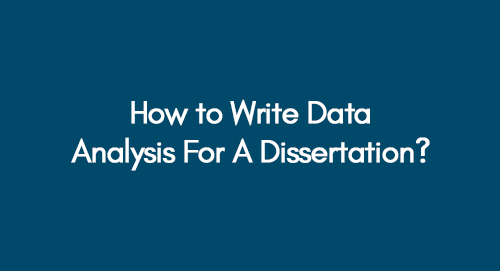
What is a Hypothesis in a Dissertation? Characteristics and Types
August 26, 2022
How to Develop a Conceptual Framework in Dissertation? |A Guideline
August 29, 2022Data analysis plans are required as part of dissertation methodologies. In your dissertation data analysis plan, you must clearly explain the statistical tests that will be used, the assumptions underlying these tests, how the scores will be cleaned and created, and the sample size required for each test.
Learn What Factors Determine the Selection of Statistical Tests Here
(1) how the hypotheses and research questions are phrased, and
(2) how the variables are measured.
Example: Regressions, for instance, are used when the question examines how variable x affects variable y; correlations and chi-square tests are used if the question examines associations or relationships, and t-tests and ANOVA are likely to be appropriate if differences are considered.
In this comprehensive guide, we'll demystify the process of how to write data analysis for a dissertation, empowering you to transform raw data into meaningful insights that drive your research forward.
What is Data Analysis in Research?
Data analysis refers to the process by which researchers interpret data to derive insights from it, according to LeCompte and Schensul. A big chunk of data can be broken down into smaller fragments by the data analysis process, which makes sense.
An analysis of data involves three essential steps - the first is organizing the data. As the second method for data reduction, summarization, and categorization are used together. Identifying and linking the data helps in finding patterns and themes. Lastly, researchers analyze data top-down as well as bottom-up.
Alternatively, Marshall and Rossman see data analysis as an ambiguous, time-consuming, messy, yet fascinating process that causes massive amounts of data to be placed in order, structured, and meaningful.
Summary: Research and data analysis are both processes involving deductive and inductive logic.
Why is the Data Analysis Plan Important for a Dissertation?
Planning and doing a dissertation is a key academic task. It involves choosing a topic, gathering and studying data, and presenting your ideas and conclusions. Collecting and analyzing data is especially vital, often taking up most of the time, leaving less for analysis and arguing.
Effective data analysis hinges on quality data. Gather data in line with research goals and audience. Good analysis and results stem from proper data collection.
Based on the nature of the data and research questions, we decided on hypothesis testing. Statistical methods match data types. Research data plans inform future research.
Researchers must sift through unnecessary data, saving time and reducing confusion.
Pro Tip: Concluding a research project isn't predictable from existing or anticipated data; bias can lead to poor research. Research varies, with some yielding quantitative and others qualitative data. Quantitative results use tables and figures; qualitative use structured documents.
Data analysis involves selecting tools, analyzing, and presenting data. It's pivotal but time-intensive. Seeking guidance aids efficient analysis. Consider tool selection, support arguments, and address issues when analyzing data. Decide on analysis depth to save time. An efficient plan saves time and aids presentation. Data analysis plans differ by discipline; careful attention is crucial.
What are the Types of Data in Research?
When assigned a specific value, every type of data describes things in a unique way. It is important to organize these values, process them, and present them in a given context in order to be able to analyze them. Various types of data can be found; here are some of the most common types.
Qualitative Data
The qualitative data is presented when there are words and descriptions. The data you observe can be analyzed in research, but it is subjective, especially regarding comparisons.
Example:
The concept of quality data encompasses everything that describes taste, experience, texture, or opinion. Surveys, focus groups, and personal interviews are common methods of collecting this type of information.
Quantitative Data
The quantitative data are numbers or numerical figures expressed as numbers. There are many ways to categorize, group, measure, calculate, or rank this type of data.
Example:
All types of data are included under this category, including age, rank, cost, length, weight, and scores. These data can be presented graphically, charted, or analyzed statistically. Data is collected through the OMS questionnaires in surveys (Outcomes Measurement Systems).
Categorical Data
In this type of data, groups of data are presented. Categorical data, however, cannot include items that belong to more than one category.
Example:
Categorical data are responses to surveys that ask about lifestyle, marital status, smoking habits, or drinking habits. Chi-square testing is a standard method for analyzing this data.
What are the Methods used for Data Analysis in Qualitative Research?
Several techniques are available to analyze qualitative data, but here are a few of the most common:
Content Analysis
This technique is widely accepted and most frequently used for data analysis in research methodology. Text, images, and sometimes physical items can be analyzed for documented information. The research questions determine the use of this method.
Grounded Theory
The best way to explain why a phenomenon occurred is to use grounded theory to analyze quality data. Studies of similar cases in different settings are conducted by applying grounded theory. By using this method, researchers might alter explanations or create new ones until a conclusion is reached.
Discourse Analysis
Discourse analysis studies how people interact, like narrative analysis. It respects social context but maintains researcher-respondent anonymity. Lifestyle and daily surroundings also influence conclusions.
Narrative Analysis
Interviews, field observations, and surveys are all content sources for this analysis method. Most of the time, people share stories or opinions aimed at answering research questions.
Get a Dissertation Proposal – Get Going!
Dissertation Proposal Lays Down the Outline of Your Final Dissertation
Get a Dissertation Proposal that matches your requirements, which includes the topic title, research aim and objective, research questions, research gap, literature review, methodology and list of reference papers.
The Dissertation Proposal will be foundation of your final dissertation. It is very important to get this done perfectly to avoid any problems!
Data Analysis in Quantitative Research
Research and data analysis begins with preparing the nominal data for analysis so they can be converted into meaningful information. Data preparation for quantitative research consists of the following phases.
First Phase: Validation of Data
Data validation aims to determine if the collected samples meet the pre-set standards or are biased. It is again divided into four stages:
Fraud: Each survey or questionnaire response should be recorded by an actual human.
Screening: Selecting or choosing participants and respondents according to the research criteria.
Procedure: Maintaining ethical standards during data collection
Completeness: In an online survey, completion refers to ensuring that all questions have been answered. Alternatively, the interviewer had asked all the questions devised in the questionnaire.
Second Phase: Editing of Data
An extensive research sample is more likely to contain errors than a smaller sample. Sometimes, respondents fill out some fields incorrectly or skip some fields accidentally. It involves confirming that the provided data is free of errors through data editing. In order to analyze the raw edit, they need to conduct necessary checks and outlier checks.
Third Phase: Coding of Data
A survey response is grouped and given a value in this phase, which is the most critical out of all three. Researchers will create an age bracket based on each respondent's age in a survey with a 1000 sample size. Small buckets of information can be easily analyzed rather than dealing with a massive pile of data.
What is the Best Way to Prepare Data for Quantitative Analysis?
Research and data analysis methods can be used to derive meaningful insights after the data is prepared for analysis. When it comes to analyzing numerical data, statistical techniques are the most common. A second classification is made based on the method. Data are described using 'Descriptive Statistics. A second type of statistical analysis is inferential statistics, which can be used to compare data sets.
Descriptive Statistics
Research uses this method to describe the basic characteristics of versatile data types. Patterns in the data begin to make sense when it is presented in such a meaningful way. It does not, however, go beyond drawing conclusions from the descriptive analysis. Researchers have based their conclusions on the hypotheses they have formulated. Descriptive analysis methods can be divided into a few main types.
Measures of Frequency
- Counts, percentages, and frequencies
- The frequency with which an event occurs is used to determine if it is frequent or not.
- It is used by researchers when they want to demonstrate how often a response is given.
Measures of Central Tendency
- The mean, median, and mode
- Various points can be used to illustrate distribution using this method.
- This method is used when researchers want to display the most common or average answer.
Measures of Dispersion or Variation
- The range, the variance, and the standard deviation
- In this case, the field equals highs and lows.
- Observed score minus mean = variance standard deviation
- A score spread can be identified by stating intervals.
- Researchers use this method to display data that is spread out in different directions. The method helps them determine how far the data spreads out until the mean is directly affected.
Measures of Position
- Quartile ranks and percentile ranks.
- Researchers can identify the relationship between different scores with the help of standardized scores.
- Researchers often use this method to compare scores with averages.
A descriptive analysis is often used for quantitative market research, but the analysis is insufficient to provide a rationale for the numbers. It is important to consider the best method for collecting and analyzing data based on the survey questionnaire and what the researchers are trying to accomplish.
Example: Students' average college grades are best shown using the mean.
Research or outcomes should be limited to the provided sample without generalizing them if researchers intend to use descriptive statistics.
Inferential Statistics
Analyze sample data, then use inferential stats to predict the whole population. For instance, a cinema asks 100 people about a song they hear. Using inference, researchers estimate 30-50% satisfaction with the movie from the sample.
Inferential statistics can be divided into two categories.
- Estimating parameters: It uses statistics to demonstrate something about the population parameter based on the sample research data.
- Hypothesis tests: It is about gathering research data in order to answer the survey research questions. Some researchers may be interested in investigating the new flavor of medicine recently introduced or whether multivitamin capsules aid children's performance in sports.
An analysis method like this shows the relationship between multiple variables instead of just describing one. Researchers often use it instead of absolute numbers to understand the relationship between variables.
The following methods are commonly used in research for data analysis.
Correlation
In contrast to experimental or quasi-experimental research, correlational research is used by researchers to study relationships between two or more variables when they are not pursuing experimental or quasi-experimental research.
Cross-Tabulation
Cross-tabulation analyzes multiple variables by studying their relationships. Assume age and gender are in rows and columns. A 2D cross-tab shows male/female in age groups, simplifying analysis.
Analysis of Variance
In an experiment, the statistical method determines the extent to which two variables differ or vary from each other. It means that research findings were significant if there was a significant degree of variation. Both ANOVA and variance analysis can be used in many contexts.
Frequency Tables
A statistical procedure determines how two or more variables differ or vary in an experiment. Research findings are considered significant when there is a substantial degree of variation. It is common to compare ANOVA testing with variance analysis in many contexts.
Regression Analysis
Researchers use regression for predictive analysis, studying strong relationships between variables. It has a key dependent variable and multiple independents. Discover how independents affect it, assuming random derivation.
What are Some Considerations for Research Data Analysis?
- In order to demonstrate a high standard of research practice, researchers must possess the necessary skills to analyze the data. A researcher should be able to understand the rationale for choosing one statistical method over another to gain better insight into data.
- Data analysis and research methods vary by scientific discipline, so it is helpful to get statistical advice at the beginning of the process to design survey questionnaires, choose data collection methods, and select samples.
- Providing unbiased insights into data is the objective of data analysis and research. The inference drawn from data collection, analysis, or audience sample will be biased if one keeps a biased mind.
- The poor definition of objective outcome measurements is irrelevant to the research data and analysis sophistication. Insufficient clarity can mislead readers, regardless of whether the design is flawed or the intentions are unclear.
- In research, data analysis aims to present accurate and reliable results. Consider ways to handle everyday challenges such as outliers, missing data, data alteration, data mining, or creating graphical representations in order to avoid statistical errors as much as possible.
FAQs About Data Analysis for Dissertations
Get 3+ Free Dissertation Topics within 24 hours?
How many phases does quantitative data analysis have? A quantitative research study involves the following phases for data preparation.
Data validation is the first phase
To determine whether the samples collected meet the pre-established standards or if they are biased, data validation is conducted
Editing the data is the second phase
The odds of errors in a large research sample are higher than in a smaller sample. Responses are sometimes filled out incorrectly or some fields are skipped accidentally. Data editing is the process of verifying if the data provided is error-free.
Coding of data is the third phase
The most critical phase of the survey is when a response is grouped and assigned a value. Using a sample size of 1000 respondents, researchers will create an age bracket based on their age.
Free Dissertation Topic



























